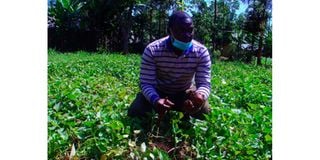Sweet potatoes gave me better deal after losses

Gabriel Akali on his sweet potato farm in Khwisero, Kakamega County.
What you need to know:
- Sweet potato is a climate resilient crop. It requires less labor unlike other crops.
- Farmers are advised to rotate heavy feeder crops with sweet potato so that it can utilise the remaining nutrients.
Gabriel Akali, 33, quit his job in 2016 to venture into farming in Kakamega County. He grows orange-fleshed sweet potatoes.
The venture that has brought him fame that saw him appointed a board member of Sweet Potato Skill Sector Advisory Committee (SSAC).
When did your love for farming start?
I started farming in 2007 when I completed secondary school. I remember planting cabbages on the family’s half-acre farm and they did so well, but I later got disappointed when I could not sell them due to lack of market. However, this did not discourage me, I still studied horticulture at the Jomo Kenyatta University of Agriculture and Technology. After completing my education, I worked at a flower farm and joined another horticulture farm before quitting to farm.
How was the transition to farming?
A little bit rough. I knew farming was not a walk in the park but I was brave enough to pursue my goal. Besides losing cabbages, I had also tried my hand in sweet potatoes while still employed and failed terribly. I had requisite experience, so I believed. I invested in two tomato greenhouses in Kakamega in 2017, ploughing Sh400,000 into the business but diseases and bad weather conspired against me. Strong winds blew away the structure. I used to wake up at 3am and ask God tough questions. But I did not give up. Later, I moved into sweet potatoes under the name Gapephi Farm Ventures.
Why sweet potatoes?
Sweet potato is a climate resilient crop. It requires less labor unlike other crops. I started farming it when I had lost all my savings and it gave me hope in the industry. I am now doing other side things like greenhouse fabrication but all that is from sweet potato business. I farm the orange-fleshed variety.
Where do you get seedlings?
GIZ, the German development organisation, which partners with Kalro-Kakamega, played a big role in me getting the first quality planting materials. Today, we source them from Kenya Plant Health Inspectorate Service (Kephis) and other certified nurseries.
How does one plant and manage sweet potatoes, from seedlings to harvest?
You have to select a field that is well drained. Deep cultivation to break the hard pan is necessary to avoid oblong tubers. Before doing anything, one has to decide on what the target market wants. We have so many varieties of sweet potato grow but broadly, you either are growing the processing variety or for local consumption ones.
Processing varieties include Kabonde, Vitaa, Kenspot 3-5, American or Caroti and Irene. Local varieties include Haraka, Bungoma, Kenspot 1, Chebolol etc. I am mentioning names because many farmers don’t know what to go for in the industry. Supermarkets want smooth-shaped varieties like Irene and American. Just before farmers decide to plant, they must have knowledge of varieties and where to sell them.
After deciding on variety, raise beds 30cm high and 75cm to 90cm wide. Plant spacing is 30cm from plant to another and vines are planted in a slanting position. At least three nodes inside the soil and one node out but new technologies like rooted seedlings is still being studied.
Normally they require moderate nutrient but good amounts of potassium and muriate of potash are good.
In most cases, we advise farmers to rotate heavy feeder crops with sweet potato so that it can utilise the remaining nutrients. With the coming of export market, soil testing becomes critical component because we need optimal production. Weeding is done within the first month. By second month, the tubers start forming and very minimal activity should be happening around the root zone.
What is your role as a board member of SSAC?
To participate in the development and review process of the sweet potato value chain curriculum.
You recently signed a swet potato export contract, tell us about it..
I signed a sweet potato contract to export to European Union, what actualised my dream in farming. My plan is to get support and open a processing facility in Kakamega next year to enable us export processed orange-fleshed tubers to Europe. I recently stopped doing actual production to focus on post-harvest handling and marketing.
What big lessons has your learnt?
Failure in something should be your turning point. Training is also key, I was trained in the GIZ green innovation programme how to produce clean sweet potato planting materials and commercial cultivation of the crop. Further, I have learnt that farming is for all, but only agriprenuers make money. There are three rules to follow when joining the industry as a novice. First is have a mentor, be ready to save and face the industry.





